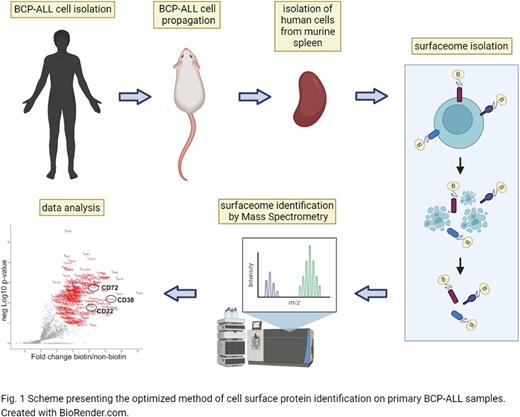Abstract
Background:
B-cell precursor acute lymphoblastic leukemia (BCP-ALL) is caused by abnormal expansion of immature B cells. Genetic alterations can be identified in most of the BCP-ALL cases, however, some specific lesions including rearrangements of the mixed lineage leukemia (MLL) gene encoding lysine methyltransferase 2A (KMT2A) are associated with particularly poor prognosis. This MLL-rearranged subtype of leukemia poorly responds to conventional treatment and frequently undergoes a lymphoid-to-myeloid lineage switch in response to CD19-directed immunotherapy with consequent loss of B cell-specific targets for immunotherapy. Therefore, there is an urgent need to identify new targets for treatment of relapsed/refractory MLLr-BCP-ALL. Attractive targets may be found in a cell surfaceome, as membrane proteins are often expressed abnormally on cancer cells and are more accessible for therapeutics. Membrane proteins also play key roles in mediating external signaling and interactions with the microenvironment, thus being essential for cancer cell survival. RNA-based data may not always correlate with plasma membrane protein levels. Therefore, we performed the analysis of the BCP-ALL cell surfaceome by biotin labeling of plasma membrane proteins followed by tandem mass spectrometry (LC-MS/MS). This method requires high cell input and therefore was previously applied exclusively to cell lines. However, the cell lines often do not represent primary samples correctly due to genetic modifications and culture conditions. We have optimized the protocol of plasma membrane protein isolation and LC-MS/MS identification of patient-derived xenografts (PDXs) BCP-ALL cells. We confirmed the LC-MS/MS results by flow cytometry. Additionally, we compared the surfaceomes of PDXs BCP-ALL cells with BCP-ALL cell lines.
Methods:
Mononuclear leukocytes were extracted from bone marrow taken for routine diagnostic procedures. The percentage of leukemic blasts in the isolates was confirmed using flow cytometry. Leukemic blasts isolated from 6 BCP-ALL patients with MLL-rearrangements were transplanted into NSG (NOD scid gamma) mice via tail vein injections. The whole blood staining was performed to evaluate the engraftment of leukemic cells. BCP-ALL PDXs were collected from spleens of leukemic mice when the percentage of human blasts in peripheral blood reached around 100%. The purity of the isolated human blasts was confirmed by flow cytometry. Next, cell surface proteins were isolated from the PDXs BCP-ALL cells using the optimized protocol, and the samples were analyzed by LC-MS/MS. All the samples were prepared in quadruplicates and unlabeled cells were used as controls. Tissue specificity was evaluated using TissueEnrich R package, with Human Protein Atlas and GTEx databases used as a reference.
Results:
We profiled six BCP-ALL PDXs and one cell line SEM, all with MLL translocations. In BCP-ALL PDXs we identified 1409 membrane-associated proteins, 935 of which were present in at least 3 samples. Tissue specificity analysis demonstrated that 93 of these proteins are specific for lymphoid cells, including already reported promising immunotherapeutic targets CD19, CD22, CD38, CD70, CD72, CD79A, and CD79B. The expression of selected proteins was confirmed by flow cytometry and compared to the expression on B-ALL cell lines with MLL translocation. Moreover, we identified an additional subset of proteins with potential therapeutic significance, which will be further analyzed. Importantly, we observed profound differences between surfaceomes of BCP-ALL cell lines and PDX cells.
Conclusions:
We have optimized the method of cell surface protein identification on primary BCP-ALL samples (Fig.1). It allowed us to overcome the technical issues of proteomics analysis of samples from the patients and to identify a subset of surface proteins, which can be promising targets for immunotherapy.
Disclosures
No relevant conflicts of interest to declare.
Author notes
Asterisk with author names denotes non-ASH members.


This feature is available to Subscribers Only
Sign In or Create an Account Close Modal